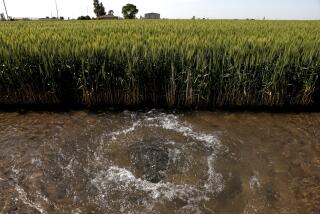California homeowners could get a tax break to capture rainwater in their backyards
- Share via
Reporting from Sacramento — It was raining and Judy Adler had a broken gutter. What could have been a simple repair turned into an effort to capture rain and use it for her backyard pond. Since late 2009, Adler has collected up to 11,000 gallons of rain annually at her Walnut Creek home.
“This is doable,” she said. “This is Tinker Toy stuff.”
More people could follow in Adler’s steps under a bill in the California Legislature. The proposal, which would encourage homeowners to collect rainwater, could make its way onto the 2018 statewide ballot.
New construction, renovation, new ownership and some purchases for a home require a property tax reassessment, which typically increases a tax bill. A proposal from state Sen. Steve Glazer (D-Orinda), SCA 9, would exclude rainwater capture systems from property tax reassessments starting in 2019.
California homeowners could see savings up to a couple hundred dollars a year off their property tax bill, depending on the type of capture system they install, Glazer’s office said.
Glazer said it’s a way to offer homeowners an incentive to conserve water and prepare for the dry season.
“It’s not an invisible occurrence when the rain comes to see water you could utilize at your home disappearing down the gutters,” he said.
Additions and improvements such as solar capture systems, certain types of seismic retrofits, fire sprinklers and modifications for disability access are already exempt from new construction classification under state law.
Glazer plans to have the Assembly take up his bill when the Legislature reconvenes. SCA 9 would appear on the June ballot if it passes before Jan. 25. If it passes later, it would be placed on the November 2018 ballot.
California voters will see several initiatives placed on the ballot by lawmakers, including bonds for housing and parks and water system improvements, rules for how to spend revenue from the state’s cap-and-trade program and a guarantee that funds collected from the state’s gas tax increase will be used only for road projects.
Adler brought the rainwater harvesting idea to Glazer. A proposal she submitted and Glazer’s idea for the tax exclusion became the basis of the bill.
A 2012 law authorized California landowners to install and operate rainwater capture systems. SCA 9 and an accompanying Senate bill also authored by Glazer would allow the Legislature to exclude new rainwater capture systems from being classified as new construction.
“You’re providing this clarity that you won’t trigger an increased tax value,” said Bob Raymer, technical director of the California Building Industry Assn., which supports the bill.
Currently, if homeowners want to install a capture system, they would apply for a building permit. Once the new construction is complete, the county assessor’s office examines it and comes up with a value. The assessment would factor into the property’s value and taxes.
If SCA 9 passes, the state’s tax agency, the Board of Equalization, will guide county assessors on how to treat rainwater capture systems as an exclusion from new construction, said Mark Nisson, a technical advisor for the board.
Additions to a home that are not considered new construction are typically not assessed until there is a new property owner, he said.
There is little evidence that excluding water harvesting systems from assessments would cause local governments to lose much revenue from property taxes. About $1 million in rainwater capture systems could equal a $10,000 loss in local revenue, according to a BOE estimate.
Gov. Brown signs 15 housing bills to help the affordability crisis »
The proposition has had almost no opposition. One group, the California Tax Reform Assn., took issue with the property tax exclusion.
By investing in rainwater capture systems, homeowners can help protect the environment without making major changes to their lifestyles, Glazer said.
“For some, that’s the only incentive they need,” he said. “The property tax exemption would be a cherry on top.”
Rainwater collection systems can cost a couple hundred to thousands of dollars, depending on the type of system and how many gallons can be stored. Adler said she paid about $6,000 for materials and plumbing expertise to install her system.
Raymer said water collection systems could help homeowners reduce the amount of money they spend on irrigation.
“It’s the best way to get the biggest bang for their buck,” he said.
A homeowner living in an area that receives 12 inches of rain annually can collect up to 10,000 gallons of water from a 1,500-square-foot roof, according the American Rainwater Catchment Systems Assn., a nonprofit based in Arizona.
The League of California Cities, a coalition of city officials, supports Glazer’s measure because it encourages water independence. Local rain capture could help save money and reduce the need to transport water from elsewhere, said Erin Evans-Fudem, a lobbyist for the association.
Glazer said the growth and expansion of solar energy in California has made him hopeful about the potential for rainwater harvesting systems.
“It’s a new field,” he said. “It could use the advantages of small tax break to motivate people to be early adopters and hopefully make it mainstream.”
Twitter: @mlcorpuz
ALSO:
Plan for billions of dollars in parks and water improvements will be on California’s 2018 ballot
Gov. Jerry Brown was less picky in 2017, vetoing fewer bills than he did in 2016
What the California Legislature accomplished in 2017
More to Read
Get the L.A. Times Politics newsletter
Deeply reported insights into legislation, politics and policy from Sacramento, Washington and beyond. In your inbox three times per week.
You may occasionally receive promotional content from the Los Angeles Times.










